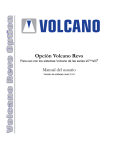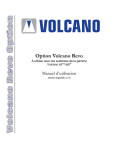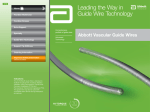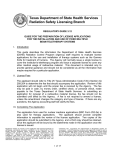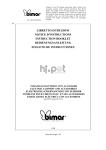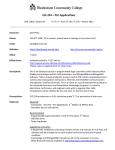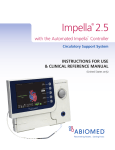Download using the revolutiontm rotating imaging catheter
Transcript
Volcano Revo Option For use with the Volcano s5™/s5i® Series Systems Operator’s Manual Software Version Level 3.3.X Complies with the Council Directive 93/42/EEC. Volcano systems meet TUV’s safety requirements. Attention: Read Operator’s Manual and Instructions For Use prior to using this device. Please contact your local Volcano representative for translated versions. This device contains mercury; dispose according to state/local laws. Do not dispose of this device or its components. Improper disposal may be harmful to the environment and human health. Please refer to www.volcanocorp.com for instructions on disposal. Manufactured by: Volcano Corporation 2870 Kilgore Road Rancho Cordova, CA 95670 USA Phone: 916.638.8008 Phone: 800.228.4728 (USA and Canada) Fax: 916.638.8112 www.volcanocorp.com Authorized European Representative: Volcano Corporation Europe BVBA/SPRL Excelsiorlaan 41 B-1930 Zaventem, Belgium Phone: +32.2.679.1076 Fax: +32.2.679.1079 © 2012 Volcano Corporation. All rights reserved. No part of this manual may be reproduced in any form without the written permission of Volcano Corporation. Revision Date: November 2012 Page 2 of 22 505-0100.14/002 Table of Contents WARRANTY.................................................................................................................................. 4 PATENTS AND TRADEMARKS................................................................................................ 5 PATENTS .................................................................................................................................... 5 TRADEMARKS .......................................................................................................................... 5 WARNINGS AND PRECAUTIONS ........................................................................................... 6 FOR USE ONLY BY TRAINED MEDICAL PERSONNEL ..................................................... 6 READ AND REVIEW MANUAL BEFORE OPERATION....................................................... 6 CONTACT INFORMATION ....................................................................................................... 7 CHAPTER 1: OVERVIEW .......................................................................................................... 9 DEVICE DESCRIPTION ............................................................................................................ 9 INTENDED USE ....................................................................................................................... 10 INSTALLATION ....................................................................................................................... 10 CATHETERS ............................................................................................................................. 10 CHAPTER 2: PREPARING FOR A CASE .............................................................................. 11 CONNECTING SPINVISION (PIMR) TO THE SYSTEM...................................................... 11 PREPARING SPINVISION (PIMR) FOR USE ........................................................................ 11 CHAPTER 3: IMAGING ............................................................................................................ 13 SETTING PULLBACK SPEED ................................................................................................ 14 USING TIME-GAIN COMPENSATION (TGC) ...................................................................... 14 USING HI-QTM FEATURE........................................................................................................ 15 PERFORMING AN AUTOMATIC PULLBACK .................................................................... 16 PERFORMING A MANUAL PULLBACK .............................................................................. 17 POST-IMAGING PROCEDURE .............................................................................................. 17 CHAPTER 4: TROUBLESHOOTING ..................................................................................... 19 POTENTIAL IMAGING ARTIFACTS..................................................................................... 19 CHAPTER 5: TECHNICAL SPECIFICATIONS.................................................................... 21 SPINVISION (PIMR) DIMENSIONS AND WEIGHTS .......................................................... 21 CATHETER SPECIFICATIONS .............................................................................................. 21 MEASUREMENT ACCURACY .............................................................................................. 22 PACKAGING ............................................................................................................................ 22 505-0100.14/002 Page 3 of 22 Warranty NOTICE: Manufacturer’s Specifications and Policies Subject to Change. Volcano Corporation reserves the right to make changes in the products described in this manual in order to improve design or performance. Reproduction or distribution of any portion of this manual without the prior written consent of Volcano Corporation is prohibited. LIMITED WARRANTY Subject to the conditions and limitations on liability stated herein, Volcano Corporation (“VOLCANO”) ® warrants that the Volcano PIMr (SpinVision ) (the “System”) as so delivered, shall materially conform to Volcano’s then current specifications for the System, for a period of one year from the date of delivery. ANY LIABILITY OF VOLCANO WITH RESPECT TO THE SYSTEM OR THE PERFORMANCE THEREOF UNDER ANY WARRANTY, NEGLIGENCE, STRICT LIABILITY OR OTHER THEORY WILL BE LIMITED EXCLUSIVELY TO SYSTEM REPAIR, REPLACEMENT OR, IF REPLACEMENT IS INADEQUATE AS A REMEDY OR, IN THE OPINION OF VOLCANO, IMPRACTICAL, TO REFUND OF THE PRICE PAID FOR THE SYSTEM. EXCEPT FOR THE FOREGOING, THE SYSTEM IS PROVIDED “AS IS” WITHOUT WARRANTY OF ANY KIND, EXPRESS OR IMPLIED, INCLUDING WITHOUT LIMITATION, ANY WARRANTY OF FITNESS, MERCHANTABILITY, FITNESS FOR A PARTICULAR PURPOSE OR NON-INFRINGEMENT. FURTHER, VOLCANO DOES NOT WARRANT, GUARANTEE, OR MAKE ANY REPRESENTATIONS REGARDING THE USE, OR THE RESULTS OF THE USE, OF THE SYSTEM OR WRITTEN MATERIALS IN TERMS OF CORRECTNESS, ACCURACY, RELIABILITY, OR OTHERWISE. Buyer understands that VOLCANO is not responsible for and will have no liability for any items or any services provided by any persons other than VOLCANO. VOLCANO shall have no liability for delays or failures beyond its reasonable control. Additionally, this warranty does not apply if: 1. The System is operated in other than a manner prescribed by Volcano Corporation in the Operator’s Manual, and/or supplements. 2. The System is operated in a manner that is not in conformance with purchase specifications and specifications contained in the Operator’s Manual, and/or supplements. 3. The System is not maintained in accordance with procedures in the Operator’s Manual, and/or supplements. 4. The System is repaired, altered, or modified in any way by other than Volcano Corporation authorized personnel, or without Volcano Corporation authorization. Contact Volcano Corporation Field Service for instructions and issuance of a Return Material Authorization if claims under this warranty become necessary and if the System or components of the System are to be returned. The System or components will not be accepted for warranty purposes unless the return has been authorized by Volcano Corporation. System parts or components repaired or replaced under warranty bear the same warranty expiration date as the original equipment. Consumable parts (data disks, batteries, among others) are warranted only against defects in materials and workmanship. System parts purchased outside the original warranty period are warranted for a period of 90 days, subject to all of the restrictions contained in this Limited Warranty. Use of unauthorized replacement parts may void the warranty. In all cases, Volcano Corporation will be the sole judge as to what constitutes warrantable damage. Page 4 of 22 505-0100.14/002 Patents and Trademarks Patents This product, and the use thereof, may be covered by one or more of the following U.S. and international patents: 7074188 8104479 JP 2005537052 7215802 8105237 JP 2007105450 7359554 EP 1534137 JP 2007518488 7463759 EP 1534139 JP 2007526083 7627156 EP 1536727 JP 2008526387 7789834 EP 1703842 JP 2008543511 7874990 EP 1732461 JP 2009530068 7899224 EP 1903944 JP 2011036680 7927275 EP 1933711 JP 2011245326 7930014 EP 1996080 JP 2011521730 7940969 EP2291121 JP4700622 7978916 JP 2005536265 JP4773092 7988633 JP 2005536289 JP4481824 Other U.S. and international patents are pending. Trademarks The following are trademarks of Volcano Corporation: Volcano and the Volcano logo are trademarks of Volcano Corporation and are registered in the United States and other countries. Revolution is a registered trademark of Volcano Corporation. Hi-Q TM is a trademark of Volcano Corporation. TM ® s5 is a trademark of Volcano Corporation. S5i is a registered trademark of Volcano Corporation. SpinVision is registered in the United States and is a trademark in the European Community and Japan. In-Line Digital is a trademark of Volcano Corporation and is registered in the European Community. 505-0100.14/002 Page 5 of 22 Warnings and Precautions WARNINGS are used to indicate the possibility of severe personal injury. Follow the instruction or procedure correctly to avoid injury to the operator, patient, or other personnel. The warnings are identified by the exclamation symbol. CAUTIONS are used to indicate the possibility of damage to the equipment. Follow the instruction or procedure correctly to avoid damage to the equipment. For use only by trained medical personnel CAUTION: FEDERAL LAW RESTRICTS THIS DEVICE TO SALE BY OR ON THE ORDER OF A PHYSICIAN (OR PROPERLY LICENSED PRACTITIONER) Read and review manual before operation Carefully read and review the entire Volcano system operator’s manual. Refer to the section “Warnings and Precautions”. VOLCANO Corporation makes no warranty, representation or condition of any kind, expressed or implied (including any warranty of merchantability, suitability or fitness for a particular purpose) respecting the misuse of the system, software or catheter. VOLCANO Corporation assumes no responsibility or liability for incidental or consequential damages which may result from re-use or misuse of the system, software or catheter. WARNING: Always ensure that SpinVision (PIMr) is placed in a stable location and is clear from items that may interfere or prevent smooth movement during use. The SpinVision weight will transfer as the device performs a pullback. WARNING: SpinVision’s (PIMr) cable may be damaged if equipment is rolled on it. Do not pull on the cable, place the cable in a high traffic area, or use excessive force as the strain relief ends may be damaged. Do not use the system if the outer case or wires appear damaged. WARNING: Do NOT advance SpinVision (PIMr) while the catheter is imaging. NOTE: SpinVision (PIMr) complies with the fluid ingress requirements of IEC 60529 IPX4 when configured for normal use. SpinVision (PIMr) should be located under a sterile drape when configured for normal use. Page 6 of 22 505-0100.14/002 NOTE: Please refer to the Volcano system operator’s manuals for detailed information about the operation of the Volcano system. Pay careful attention to all Cautions and Warnings. CAUTION: Do not use a damaged catheter. Do not re-sterilize the catheter. Catheters are shipped sterile for single use. In the event of damage, contact Volcano Corporation personnel. CAUTION: The top surface of SpinVision (PIMr) Models 808884001 and 808884001-R can become hot to the touch during prolonged periods of use. Contact Information United States: Volcano Corporation 2870 Kilgore Road Rancho Cordova, CA 95670 USA Phone: 916.638.8008 Phone: 800.228.4728 (USA and Canada) Fax: 916.638.8112 www.volcanocorp.com Authorized European Representative: Volcano Corporation Europe BVBA/SPRL Excelsiorlaan 41 B-1930 Zaventem, Belgium Phone: +32.2.679.1076 Fax: +32.2.679.1079 505-0100.14/002 Page 7 of 22 This page is intentionally blank for pagination purposes. Page 8 of 22 505-0100.14/002 Chapter 1: Overview This manual is intended to provide information specific to the Volcano Revo option for use on the Volcano system. Please refer to the Volcano system operator’s manuals for information regarding the system and its functionality. Device Description The Volcano-Revo option kit is a required accessory to the Volcano system when using the ® Revolution 45MHz Rotational Imaging Catheter for intravascular ultrasound imaging. This option consists of a Patient Interface Module (PIM) called SpinVision, (PIMr) which can be simply connected to the existing Volcano system PIM cable. Figure 1. Volcano-Revo Option Patient Interface Module (SpinVision/PIMr) The ability to perform an automatic or manual pullback is integrated into the SpinVision (PIMr) pullback device. The controls available on SpinVision (PIMr) include the following buttons: • • • • • Reset: Resets the LED distance display to zero Image: Press once to begin imaging. Press a second time to stop imaging. The Revolution catheter will rotate while in imaging mode. Pullback: Press to begin an automatic pullback. Press again to stop the pullback. Auto: Offers two automatic pullback rates (1.0 and 0.5 mm/sec) Manual: Offers manual control of pullbacks 505-0100.14/002 Page 9 of 22 Intended Use The Volcano Revo option is used for qualitative and quantitative evaluation of vascular morphology in the coronary arteries and vessels of the peripheral vasculature. It is used as an adjunct to conventional angiographic procedures to provide an image of the vessel lumen and wall structures. The pullback feature of the PIMr withdraws the Revolution catheter’s imaging core within the protective sheath for a maximum of 15cm. Installation To ensure proper operation and warranty coverage, the Volcano system must be installed and tested by following the Device Installation and Operational Qualification that accompanies each device. Catheters Revolution 45MHz Rotational Imaging Catheter 89000 Note: The Revolution® catheter is intended for the intravascular ultrasound examination of coronary arteries. Intravascular ultrasound imaging is indicated in patients who are candidates for transluminal interventional procedures. Page 10 of 22 505-0100.14/002 Chapter 2: Preparing for a Case Refer to the Volcano system operator’s manuals for the general instructions on preparing for an IVUS case. Connecting SpinVision (PIMr) to the System SpinVision (PIMr) excites the catheter’s transducer element to transmit ultrasonic energy to the surrounding tissue. It then amplifies and processes the resulting echo signals from the transducer and sends them to the system through the connection on the system’s rear panel. 1. Connect the PIM cable to the rear of SpinVision (PIMr). Orient the marker on the cable connector to align with the marker on the PIM connector, then slide the connector in. If you need to remove the cable from SpinVision (PIMr), rotate the collar on the SpinVision (PIMr) cable connector counterclockwise a quarter turn and then pull back. 2. SpinVision (PIMr) performs a diagnostic self-test and displays any errors on the system screen. 3. The SpinVision (PIMr) connection will be confirmed in the lower right hand section of the screen. A green light with the words “Rotational” will display once SpinVision (PIMr) is connected. WARNING: SpinVision’s (PIMr) cable may be damaged if equipment is rolled on it. Do not pull on the cable, place the cable in a high traffic area, or use excessive force as the strain relief ends may be damaged. Do not use the system if the outer case or wires appear damaged. Preparing SpinVision (PIMr) for Use 1. Remove the sterile equipment drape from the Revolution box. 2. While maintaining sterility, remove the sterile drape from its protective packaging. 3. This step requires two people. The sterile person opens the sterile drape on the side with the green arrows, placing his or her hands in the back of the fold(s) to keep it open. The second person places SpinVision (PIMr) into the sterile drape as far as it will go in the direction of the green arrow on the drape. 4. Unfold and pull the drape all the way out. This will cover SpinVision’s (PIMr) cable far enough to extend out of the sterile field. 5. Once the catheter has been prepped per the Instructions for Use (IFU), insert the sterile drape catheter port into the SpinVision (PIMr) catheter port. 6. Remove the sterile barrier sticker from the drape so you can insert the catheter. 7. Insert the catheter into the SpinVision (PIMr) port with the black marks on the catheter and SpinVision (PIMr) port aligned, then lock it in place by rotating it 30° clockwise. A message on the Volcano system screen reads “Catheter detected”. The system is ready for imaging once the “Press Image to Begin Imaging” message displays. 8. With the catheter telescope in the most distal position, clip the telescoping hub into the SpinVision’s (PIMr) catheter arm. 9. Press the Image button on SpinVision (PIMr) or the Image On (Live) button on the system Home screen. The image appears on the system screen. 505-0100.14/002 Page 11 of 22 WARNING: Always ensure that SpinVision (PIMr) is placed in a stable location and is clear from items that may interfere or prevent smooth movement during use. The SpinVision (PIMr) weight will transfer as the device performs a pullback. CAUTION: The IVUS PIM, SpinVision (PIMr) and the FFR Pimmette are strongly attracted to the magnetic field of Stereotaxis units. The user should observe caution in handling these devices when less than 110cm from the center of these fields in order to prevent damage to the device or personal injury should these devices become free inside these very strong magnetic fields. For reliable operation, SpinVision (PIMr) must be further than 110cm from the center of the magnetic field of a Stereotaxis unit. Inside of this limit the image may become frozen on the monitor until the unit is moved to outside this limit. Placement of the SpinVision (PIMr) inside this limit may damage the SpinVision (PIMr). Page 12 of 22 505-0100.14/002 Chapter 3: Imaging Once the Revolution 45MHz catheter and SpinVision (PIMr) device are connected, the system will display the following on the Home screen. Figure 2. Main System Screen – Image Off Select Image On (Live) button on the system screen or the IMAGE button on SpinVision (PIMr) to begin imaging. The SpinVision (PIMr) motor will begin spinning, and the Revolution image will appear on the system screen. Figure 3. 505-0100.14/002 Image On Page 13 of 22 Setting Pullback Speed The current pullback speed is indicated in the bottom of the ILD section. You can change the pullback speed by selecting the radio button at the bottom of the ILD section on the system or by selecting the SpinVision (PIMr) button for the desired speed (0.5mm/sec, 1.0mm/sec or Manual). Using Time-Gain Compensation (TGC) After selecting the Adjust Image button in the Home screen shown above, the Time Gain Compensation (TGC) feature shown below increases or decreases the gain of the input signal with respect to distance from the transducer. This feature is only available with the Revolution catheter. Six TGC profiles are available. Each can be adjusted to a user’s need. Figure 4. Time-Gain Compensation Dialog Box To set the TGC: 1. Select the TGC button in the Adjust Image screen. Note that you must be imaging with a Revolution catheter for the TGC feature to be enabled. 2. Select from one of the preset profiles using the drop down box or arrow keys. 3. Move the sliders or use the arrows to set the gain for each desired region (as indicated by the number of mm shown to the left of each slider). 4. Click Close to save your settings and close the dialog box. If you do not want to save any changed settings, click Reset. The settings will be restored to the default settings. Page 14 of 22 505-0100.14/002 Using Hi-QTM Feature The Hi-Q feature allows selection from multiple Revolution imaging options to provide an option that best allows the user to differentiate between blood speckle and tissue along lumen border. It must be enabled in the Adjust Image screen before recording images. Figure 5. Hi-Q Settings Hi-Q has three Revolution imaging mode settings: • Off: Imaging equivalent to systems with software versions prior to 3.3.X • Level 1: Imaging with a darker and finer blood speckle appearance than in Off mode (default setting) • Level 2: Imaging with a darker and finer blood speckle appearance than in Level 1 Mode To enable Hi-Q, select Level 1 or Level 2 from the Hi-Q drop-down menu. NOTE 1: The selection of Hi-Q settings should occur before recording video loops. NOTE 2: In Level 1 or Level 2 mode, diameter choices are limited to 8mm and 10mm. The Off mode allows the user to use the full range of catheter Diameters: 8mm, 10mm, 12mm, and 14mm. Diameter controls the depth of field view in which ultrasound data is displayed. Selecting Level 1 and Level 2 using unsupported diameters results in the message displays shown below. For example, if Level 1 or Level 2 is selected and then Diameter is set to12mm or 14mm, the following message displays: 505-0100.14/002 Page 15 of 22 Figure 6. Disable Hi-Q Message Conversely, if Diameter is set to 12mm or 14mm and then Level 1 or Level 2 is selected, the following message displays: Figure 7. Enable Hi-Q Message Disable Hi-Q by selecting Off from the Hi-Q drop-down menu. When the Hi-Q feature is set to Off, a visual indicator, Hi-Q Off, appears under the LIVE text, located on the upper left-hand corner of the Home screen image. Performing an Automatic Pullback 1. Using the .014” guide wire, advance the catheter to the most distal portion of the target lesion according to standard intervention procedures. 2. Select the pullback speed by pressing the AUTO button on SpinVision (PIMr), which toggles between 0.5 mm and 1.0 mm per second. To zero the distance counter, press RESET. 3. Select Image on SpinVision (PIMr) or the Image On (Live) button on the system screen to begin imaging. The SpinVision (PIMr) motor will begin spinning, and the Revolution image will appear on the system screen. The absolute movement of the transducer will be displayed on the digital readout on SpinVision (PIMr). The Image Off (Freeze), Save Frame, Record (Pullback), and Adjust Image buttons become visible on the system screen. 4. To stop imaging at any time, simply select the IMAGE button on SpinVision (PIMr) or the Image Off (Freeze) button on the system. The image currently displayed on the screen remains there. Note: Starting or stopping imaging also starts or stops the rotation of the catheter. NOTE: If an image artifact is observed, it may be necessary to flush the imaging core with a 3 cc syringe of heparinized saline attached to the Revolution catheter port.SpinVision (PIMr) 5. Press PULLBACK on SpinVision (PIMr) or Record (Pullback) on the system. Pullback begins at the selected speed, and the Volcano system begins to record the video loop. NOTE: SpinVision (PIMr) can accommodate a maximum pullback distance of 15 cm, after which it stops the pullback. Page 16 of 22 505-0100.14/002 NOTE: The pullback distance may be limited to 9 cm if the acquisition rate is set at 30 frames/sec and a pullback rate of 0.5 mm/sec is used. Adjust the acquisition rate to 15 f/s or pullback rate to 1.0 mm/sec to obtain the entire 15 cm. 6. Once the desired pullback distance is reached, you may stop the pullback by pressing the PULLBACK button on SpinVision (PIMr), or by pressing the Stop button on the system or software. Performing a Manual Pullback 1. Select MANUAL on SpinVision (PIMr). SpinVision (PIMr) unlocks from the sled so that you can move it by hand. 2. Select IMAGE on SpinVision (PIMr) or the Image On (Live) button on the Home screen. 3. Select PULLBACK on SpinVision (PIMr) or Record (Pullback) on the Home screen. 4. Gently pull SpinVision (PIMr) back at the desired speed. Utilize the rubber grips on the side of SpinVision (PIMr) to enhance control. 5. Press STOP on the Home screen to stop recording the video loop. NOTE 1: The digital display can be reset at any time to give the absolute position. NOTE 2: If the SpinVision (PIMr) motor drive is left stationary for more than 30 seconds while in Manual mode, the system will switch to Auto mode and lock the sled into place. WARNING: Do NOT advance SpinVision (PIMr) while the catheter is imaging. Post-Imaging Procedure 1. Remove the Revolution catheter using standard interventional procedures. 2. Detach the catheter from SpinVision (PIMr) by rotating the port counterclockwise 30° to unlock it and removing the telescoping hub from the SpinVision (PIMr) arm. 3. Dispose of the Revolution catheter. 4. Remove SpinVision (PIMr) from the sterile drape ensuring that no blood or fluid comes into contact with it. 5. Dispose of the sterile drape. NOTE: After the SpinVision (PIMr) is removed, the screen area will continue to display the appropriate information for the last type of PIM used. 505-0100.14/002 Page 17 of 22 This page is intentionally blank for pagination purposes. Page 18 of 22 505-0100.14/002 Chapter 4: Troubleshooting These error messages are displayed on the right hand side of the SpinVision (PIMr) message display. Use the following table to read the description and recommended action. Display Meaning Suggested User Manual Text SpinVision (PIMr) passed self-test This code displays briefly after the unit is powered on and indicates that the unit is ready. E1 Unable to read RFID The catheter may be faulty or may not be fully rotated into place. Ensure the catheter is fully rotated into place. Try another catheter. If these do not resolve the problem, call Volcano Technical Support. E2 TGC memory failure The unit has failed. Call Volcano Technical Support. E3 Analog high voltage failure The unit has failed. Call Volcano Technical Support. E4 One of the pulse width control pins is stuck low The unit has failed. Call Volcano Technical Support.. Catheter motor failure Catheter rotation has stalled. Ensure the catheter has been prepared and flushed per the catheter IFU. If this does not correct the problem, call Volcano Technical Support. E6 Pullback motor driver failed Ensure the pullback has not come to the end of its travel. Check the cable for binding and the catheter for excessive drag in the body. If these do not correct the problem, call Volcano Technical Support. E7 EEPROM data error The unit has failed. Call Volcano Technical Support. E0 E5 Potential Imaging Artifacts Artifact Cause Resolution Degraded image due to shadowing Air surrounding the IVUS transducer within the catheter sheath Flush with heparinized saline per IFU Non-Uniform Rotational Distortion (NURD) Excessive tightening of the hemostasis valve Loosen the hemostasis valve Excessive bending of the catheter Make sure catheter is not bent between SpinVision (PIMr) and hemostasis valve. Flushing with heparinized saline may also help. Air surrounding the IVUS transducer within the catheter sheath Flush with heparinized saline per IFU Ring artifact in image 505-0100.14/002 Page 19 of 22 This page is intentionally blank for pagination purposes. Page 20 of 22 505-0100.14/002 Chapter 5: Technical Specifications NOTE: Refer to Volcano system operator’s manuals for system specifications. SpinVision (PIMr) Dimensions and Weights SpinVision (PIMr) Height Width Depth Weight 806071026 3.9 in 9.9 cm 4.0 in 10.2 cm 14.4 in 36.6 cm ~3.2 lb 1.5 kg 808884001 3.9 in 9.9 cm 4.0 in 10.2 cm 14.4 in 36.6 cm 2.9 lb 1.3 kg Catheter Specifications Imaging catheter - Revolution 45MHz Rotational IVUS Imaging Catheter Transducer type Piezoelectric Frequency Revolution 45MHz Rotational IVUS Imaging Catheter 360° view, single-element rotating transducer Lumen characteristics coaxial, guide wire lumen Catheter Revolution Catheter Revolution Crossing Profile at Transducer 3.2F (1.07 mm) Maximum guide wire 0.014” (0.36 mm) Minimum ID guiding catheter clearance 6F (1.63 mm) ≥ .064” Length, cm 135 NOTE: Refer to “Instructions for Use” (IFU) that accompanies each catheter or go to www.volcanocorp.com to view detail catheter use, specifications, and acoustic output. 505-0100.14/002 Page 21 of 22 Measurement Accuracy Measurements obtained with the Revolution 45MHz Rotational IVUS Imaging Catheter are subject to the following measurement inaccuracies due to variations in tissue speed of sound and display limitations. The measurement precision is limited in both relative and absolute ranges: Distance Measurement: –4.5%, +7.0% of measured value (± 0.10mm) 2 Area Measurement: –9%, +14% of measured value (± 0.10mm ) These uncertainties apply to the entire range of measurement achievable with the Revolution 45MHz Rotational IVUS Imaging Catheter. These are worst case measurement uncertainties and represent situations where the ultrasound signals are entirely within tissue, such as muscle, which has a very different speed of sound than blood. For measurement of luminal boundaries, where the ultrasound only traverses through blood, the inaccuracy is: Distance Measurement: ± 1% of the measurement (± 0.10mm) 2 Area Measurement: ± 5% of the measurement (± 0.10mm ) NOTE: A slight difference in total pullback length displayed on SpinVision (PIMr) and ILD may exist due to the latent response in initiation/termination of the pullback relative to recording. This discrepancy only exists in the most proximal and distal 1mm of the video loop. In-Line Digital measurement accuracy • • • • Two distance measurements on the longitudinal display (ILD) Maximum Loop Distance (Z axis length) @ 0.5 mm/sec pull back & 30fps, limited by memory of 5400 frames: 90 mm Maximum Loop Distance (Z axis length) @ 1.0 mm/sec pull back, limited by device dimension: 150 mm Accuracy (including software and SpinVision (PIMr) accuracy): ± 4% of the measurement NOTE: In rare situations, the actual pullback speed may differ from the expected value. This could result in erroneous length information derived from the ILD. This can be caused by restricted motion of the PIMr or simultaneous activation of the speed controls on the PIMr and system. Packaging Catheters are shipped sterile for single use. In the event of damage, contact Volcano Corporation personnel. CAUTION: Do not use a damaged catheter. Do not re-sterilize the catheter. Page 22 of 22 505-0100.14/002






















